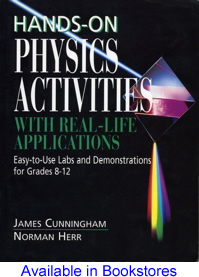Hands-On Physics Activities with Real-Life Applications - Contents
Hands-On Physics Activities
Herr, Norm and James Cunningham. (1994)
John Wiley / Jossey-Bass, Publishers
670 pages. (ISBN 0-87628-845-X).
Available
from many online book companies including:
John Wiley | Amazon | AAPT | Jossey-Bass | Borders | Barnes & Noble | BetterWorld | Tower Books
Contents | About Hands-on Physics | Back cover
This resource contains intriguing investigations designed to provide an activity‑oriented approach to learning science and to engage students in a genuine pursuit of science. It also serves as a resource book for teachers and students. Each set of activities is preceded by a concise introduction giving students a foundation on which to build their understanding, including a discussion of major concepts related to the activities.
The activities provide meaningful interactions between students and their world in a manner encouraging sound scientific reasoning. Many of the activities produce unexpected or dramatic results that capture student interest. Thoughtprovoking questions follow each set of activities. Following the questions is a section developed especially for the teacher in which concepts are explained in greater detail and directions are provided for converting some of the student activities into impressive classroom demonstrations. Also included in this section are clear and concise answers to the questions. Because students often have difficulty seeing the relevance of science, we discuss applications of the investigated principles to their everyday lives.
Activities included in the book have been successfully implemented and tested in the classroom by experienced and novice science teachers. These activities, coupled with the explanation of the underlying concepts, show that science is composed of two dimensions ‑ content and process. Science is not merely something a scientist does in the laboratory or a rhetoric of conclusions to be gleaned from a textbook or lecture and soon forgotten. The book emphasizes the "process‑dimension" of science. Without processes such as observing, measuring, and hypothesizing, there would be no scientific facts, theories, or laws.
Most of the activities can be performed with materials commonly found in the students' everyday environment. Some require equipment found in the typical science classroom or inexpensive equipment available from scientific supply houses.
Every effort has been made to ensure teachers and students will enjoy the activities so they will become meaningfully engaged in the processes of science. Consequently, they will acquire knowledge and understanding of basic science concepts and the application and relevance of these to their everyday lives.
James Cunningham, Ph.D.
Norman Herr, Ph.D.
California State University, Northridge

Contents
1 MEASUREMENT
1.1 Units
1.2 Indirect Measurement
1.3 Scaling2 MOTION
2.1 Center of Mass
2.2 Inertia
2.3 Velocity & Acceleration
2.4 Periodic Motion3 FORCE
3.1 Force
3.2 Buoyant Force
3.3 Friction
3.4 Torque4 PRESSURE
4.1 Air Pressure
4.2 Vapor Pressure
4.3 Fluid Pressure
4.4 Fluids in Motion5 ENERGY & MOMENTUM
5.1 Work & Power
5.2 Kinetic & Potential Energy
5.3 Momentum
5.4 Machines6 WAVES
6.1 Waves
6.2 Sound
6.3 Transmission of Sound
6.4 Frequency & Wavelength of Sound
6.5 Wave Properties of Sound7 LIGHT
7.1 Reflection
7.2 Refraction
7.3 Diffraction
7.4 Polarization
7.5 Optics
7.6 Color8 ELECTRICITY & MAGNETISM
8.1 Electrostatics
8.2 Circuits
8.3 Magnetism

